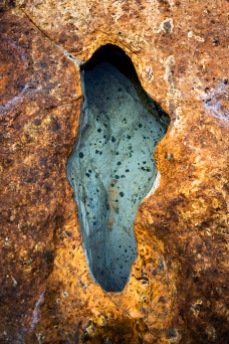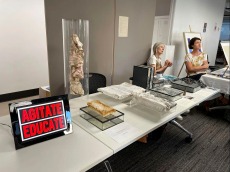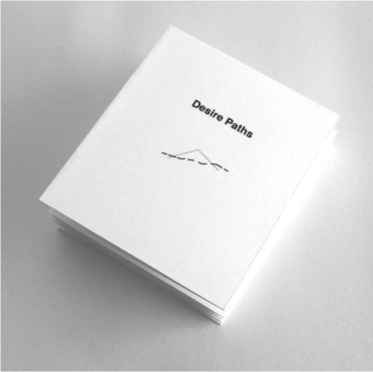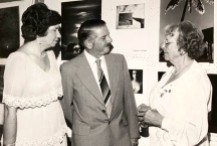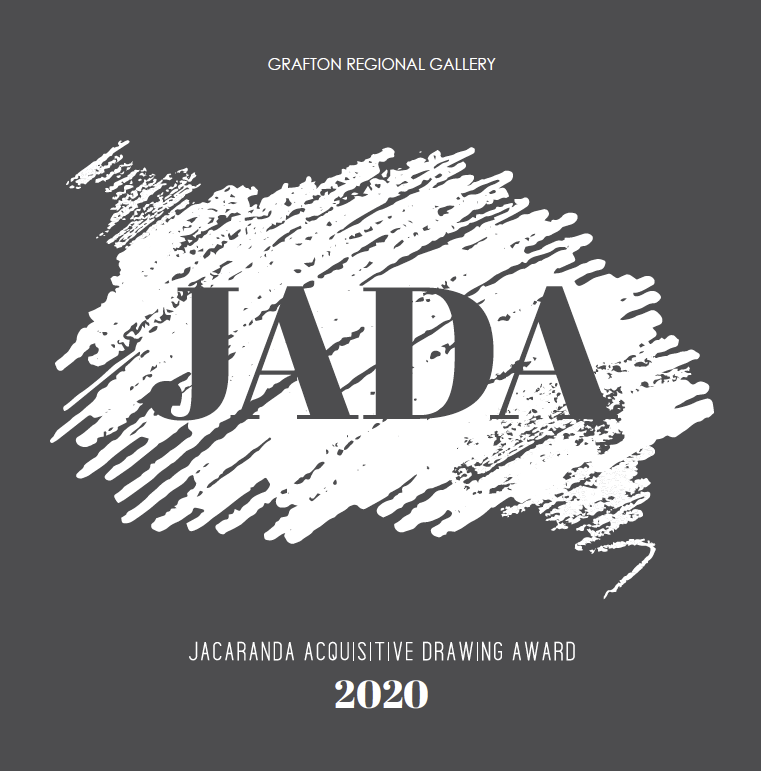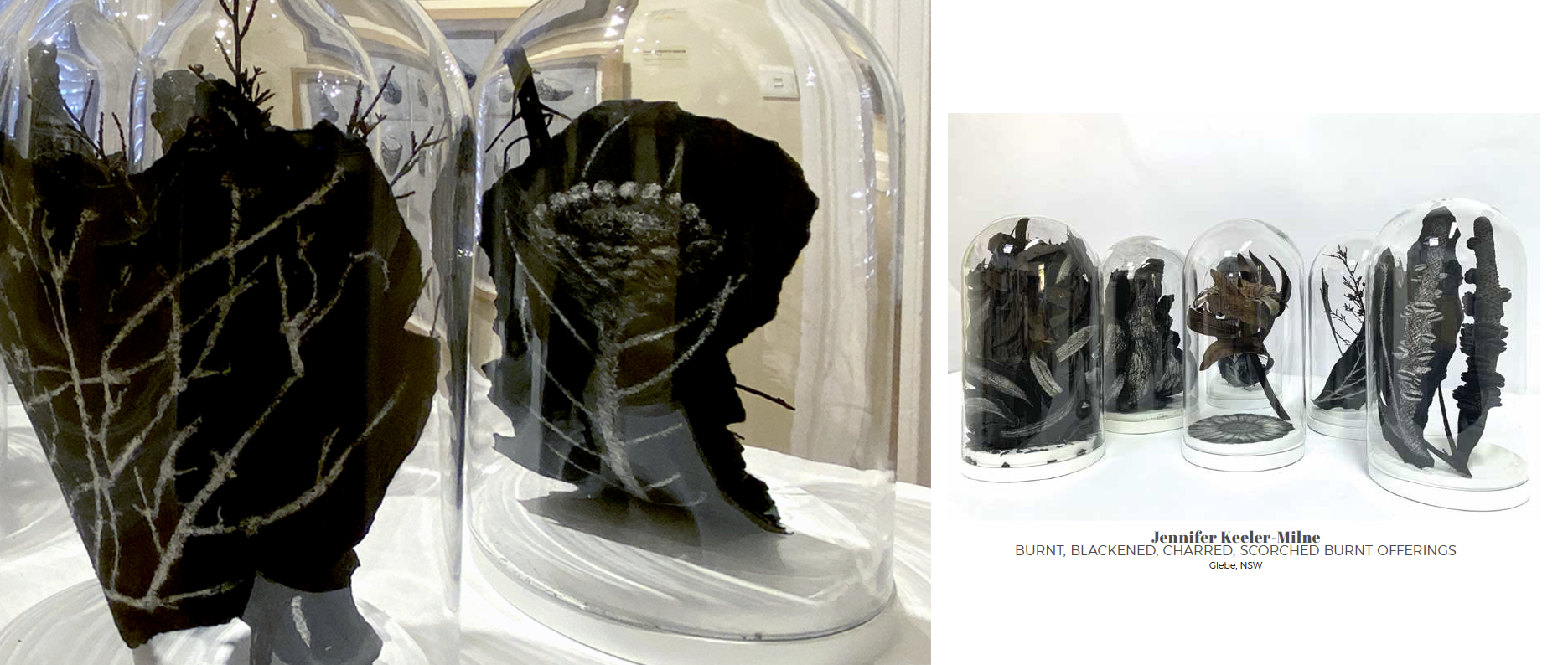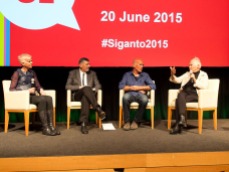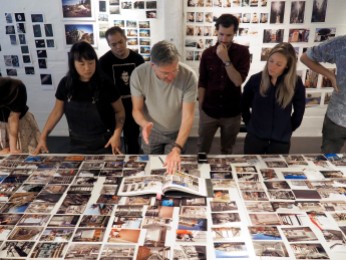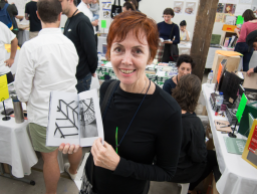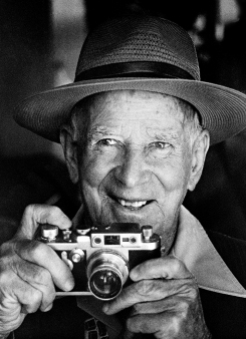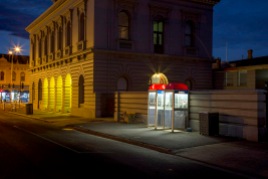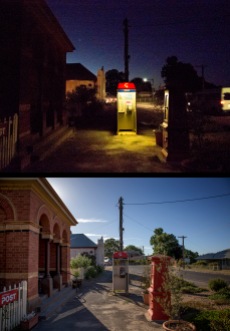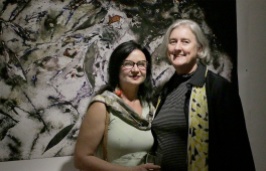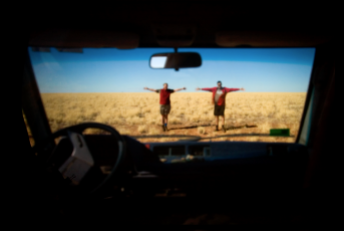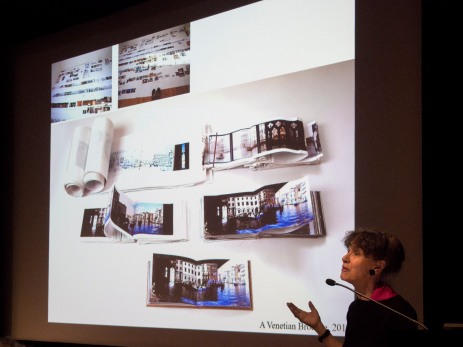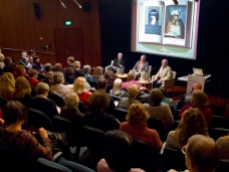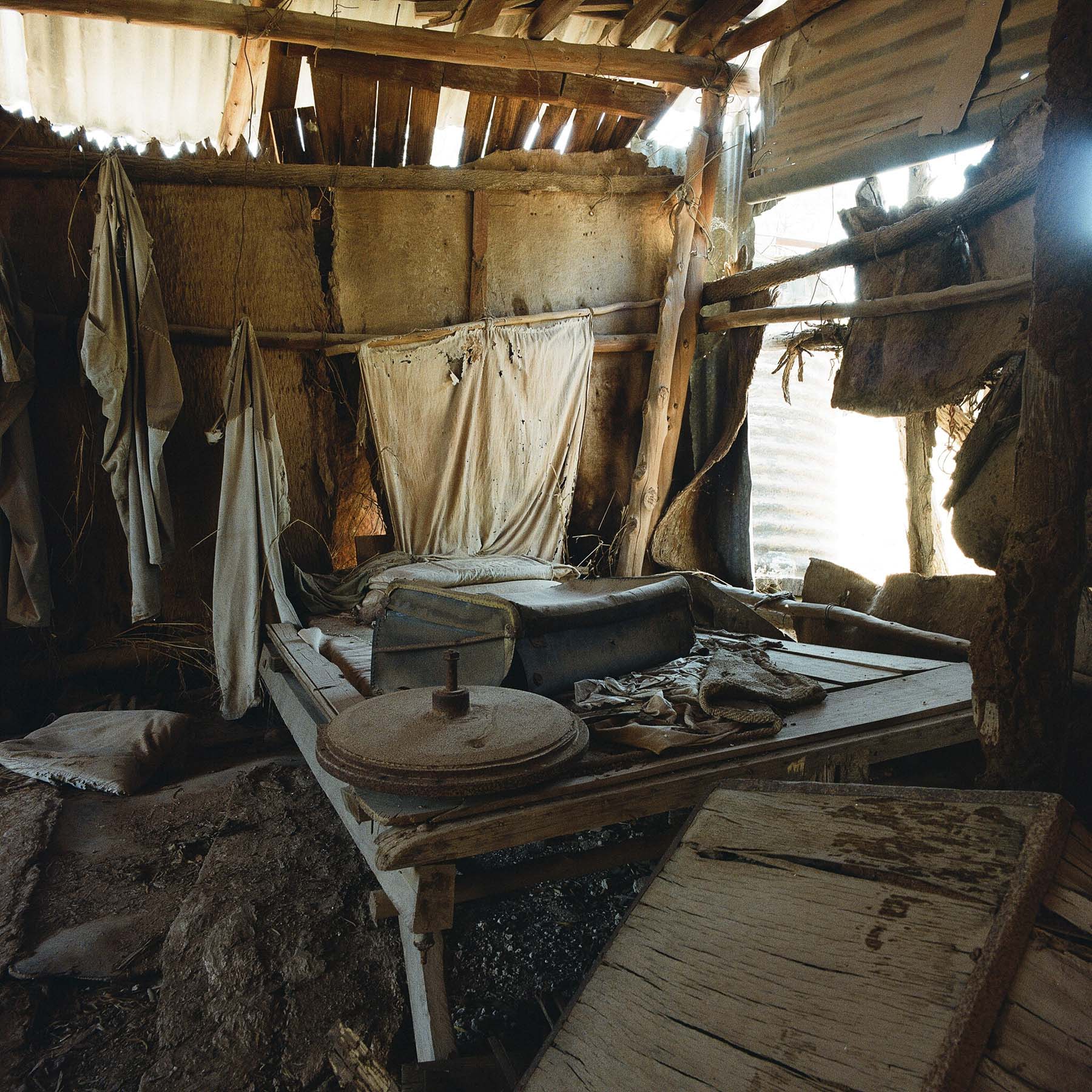Archive for the ‘wotwethink’ Category
IN THE WETLANDS: 3 Artists – Cooper + Hollins + Spowart collaborate, drawing inspiration from Winton Wetlands
.
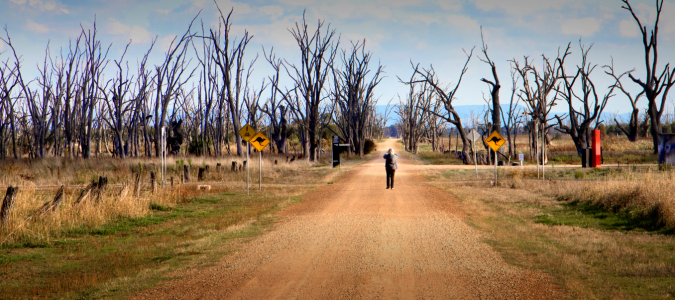
PALIMPSEST Exhibition artists in Winton Wetlands
.
The Winton Wetlands in north-eastern Victoria, also once known as Lake Mokoan, has been through many changes from farming to the building then decommissioning of a dam. Now this visually haunting and beautiful place is undergoing a new phase of regeneration – reviving the natural state of living wetland environment.
.
Dr Lisa Farnsworth, Winton Wetlands Restoration Manager, has been working with local artists to form a group that finds inspiration for their art in the Wetlands. She comments:
.
The Winton Wetlands Creatives Group is driven by a passion for the natural beauty and cultural richness of the Winton Wetlands Reserve. Through various art mediums and engagement opportunities, the group aims to advocate for the Winton Wetlands restoration project and for the ongoing protection and appreciation of its cultural and ecological assets. I’m genuinely excited to see how art, culture and ecology can align to create great outcomes for the health of our local people and natural landscapes.
.
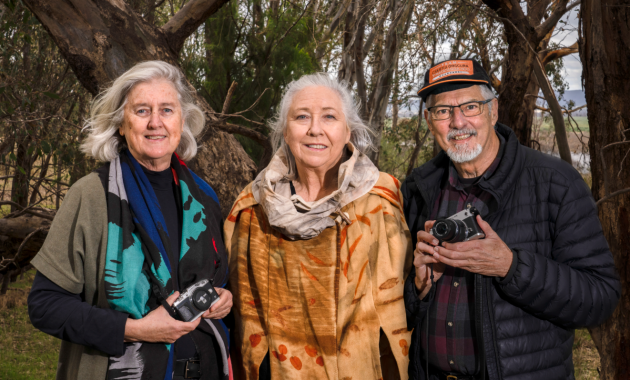
Artists Victoria Cooper, Maggie Hollins + Doug Spowart
.
In the spirit of Lisa’s vision we formed a collaboration with fellow Benalla artist Maggie Hollins to create a visual response to the Winton Wetlands inspired by its layered human and natural history and contemporary renewal. In our work we have associated this altered landscape with the concept of a palimpsest – a manuscript that was reused by writing new text over the previous words.
.
The Palimpsest features again in the exhibition where the collaboration between us as artists can be experienced as a layered narrative, where multiple stories and experiences intertwine to form a cohesive whole.
.
Check out our INSTAGRAM Project picture trail https://www.instagram.com/wetlands.palimpsest/
.
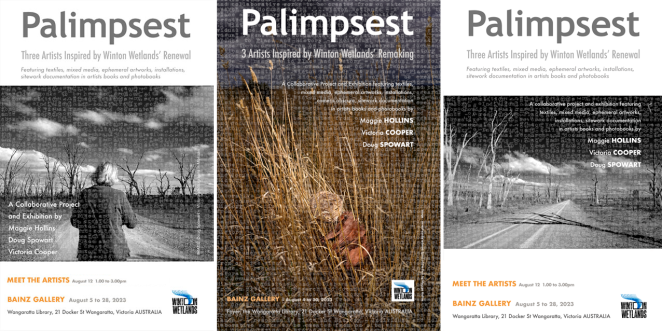
3 Invitations for the exhibition in BAINZ GALLERY in Wangaratta
.
.
SOME VIEWS OF THE EXHIBITION
.
.
SEE A FLY-THROUGH VIDEO OF THE EXHIBITION
.
.
.
A COMMENTARY ON THE EXHIBITION …
Victoria Cooper, Maggie Hollins and Doug Spowart have collaborated to produce and display a wonderful and diverse visual exhibition. They have sought to associate the altered Winton Wetlands landscape with the concept of a palimpsest. In doing so they are contributing to discussion of different, yet overlapping, stories of the wetlands.
Cooper and Spowart have been involved in the arts as practitioners, teachers and commentators for a lengthy time, including having residencies at Bundanon. Hollins has qualifications in ceramics, leads art workshops and enjoys playing fiddle. Unsurprisingly therefore, each and every artwork displayed is of a high standard.
There are unique, handmade textural and sculptural artworks by Hollins that use a diverse variety of materials – including found small branches, knotted bark, dyed cotton thread, solar and rust dyed cotton fabric, metal rings, and found grasses. They are accompanied by postcard sized images of the same artworks “displayed” on site in the wetlands. Those images were a team effort – Hollins operated the camera, Cooper was location scout and camera assistant, and Spowart did the lighting and Director of Photography duties.
There are larger standalone photographic prints and collaborative diptychs by Cooper & Spowart conveying stories of witnessing, magnificent 3 metre wide concertina photobooks by Spowart displayed folded out and attached to the wall, plus artist books and poetry by Cooper.
It all comes together splendidly, successfully conveying the messages the artists want visitors to hear.
.
BRIAN ROPE Reviewer for and member of the Canberra Critics Circle
Read Brian Rope’s full review HERE
.
.
LATER POSTS WILL FEATURE MORE ABOUT THE INDIVIDUAL ARTISTS & THEIR WORKS …
.
.
.
SEE MORE ABOUT THE WINTON WETLANDS …
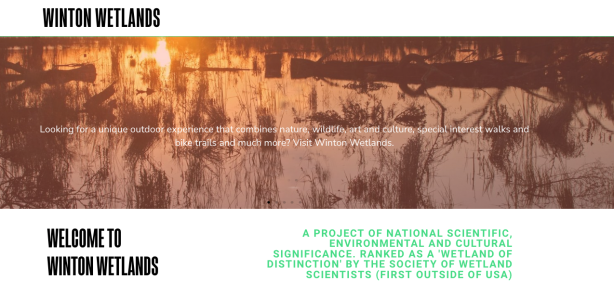
Winton Wetlands website Home page
CLICK HERE FOR THE WINTON WETLAND’S WEBSITE
.
.
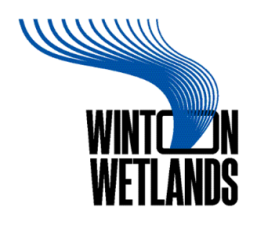
Winton Wetlands logo
.
ACKNOWLEDGEMENTS
The artists wish to acknowledge the Winton Wetlands team for their support.
We acknowledge the traditional lands of the Yorta Yorta people & their 8 clans the original owners of Country.
We respect their deep enduring connection to their lands and waterways and recognise that sovereignty was never ceded.
We honour and respect their ancestors, their Elders past, present and emerging.
.
.
.
.
.
NICHOLAS WALTON-HEALEY – SALT FRAMES
.
.
A SELECTION OF IMAGES
.

‘SPOOR’ Nicholas Walton-Healey from the exhibition SALT FRAMES

‘WHISPER’ by Nicholas Walton-Healey from the exhibition SALT FRAMES

‘SKIN’ Nicholas Walton-Healey from the exhibition SALT FRAMES

‘TOUNGE’ Nicholas Walton-Healey from the exhibition SALT FRAMES

‘CARESS’ Nicholas Walton-Healey from the exhibition SALT FRAMES
.
A COMMENTARY ON THE BODY OF WORK by Victoria Cooper
.
watch the water long enough and you’ll see a fish jump … *
.
Salt Frames review
Nicholas is a poet…
Salt Frames is simultaneously a visual and textual poem. On the surface it is an exhibition of light and colour abstractions from time spent on the Nightcliff Foreshore, Darwin. But this work also has deeper layers and meaning that are evoked through the supporting words and symbols within the images, as Walton-Healey discloses: “Sea salt aids the healing of wounds (including those beneath the surface of the skin).”
Walton-Healey points out that more broadly Australians have an affinity to the coast. The sea and the coast become places of personal meditation and for some physical and psychological healing. His seascapes are not the usual pictorial or grand panorama – instead he shares visual metaphors; those moments of revelation and contemplation that can hold many different meanings to the viewer.
The text blocks with the images are, for me, not titles but words that operate as codes to other ways of being and thinking. If we cast our minds to memories of reverie by the sea, perhaps these words articulate our collective human experience of being at the coast.
On connecting with Walton-Healey’s opening speech, the meaning embedded in the words and the images of layered light, colour and stilled moments was underpinned by a deeply moving human story. Through the visual poetry of this exhibition the artist has humbly shared vulnerability, tenderness and deep thinking. In this openness of vision he also created space for the viewer to spend time to consider and connect with our own stories and memories.
.
Dr Victoria Cooper
* A teaching by Larrakia Warrior Robert E. Lewis to Nicholas Walton-Healey
.
.
THE OPENING SPEECH BY PAMELA KLEEMANN-PASSI

Pamela Kleeman-Passi speaks
.
Acknowledgement to Country
We respectfully acknowledge the Traditional Owners of the land, the Boon Wurrung and Woiwurrung (Wurundjeri) peoples of the Kulin Nation. We extend gratitude to all Elders past and present and their enduring connection to land, sea and community.
.
.
Welcome to the Salt Frames exhibition …
.
My friendship with Nick grew out of a deeply personal connection of loss and renewal, and a mutual passion for experiencing life through the lens of creativity. And now we have Darwin in common! Our shared stories meandered and overlapped during my month there mid-last year for my own exhibition. I actually didn’t know that much about Darwin until that visit, and I returned to Melbourne with a deep fondness for the culture, the landscape and the communities. I thank Nick for facilitating a visit to the Tiwi Islands to spend a moment of precious, rejuvenating time at the Tarntipi Bush Camp on Bathurst Island.
.
So what you see within these salt frames of the Nightcliff foreshore is Nick’s immersion in and introspection on the blessings and cruelties of life, and the healing power of the water and the land. The evocative single word titles express an array of feelings and experiences and the images are imbued with opposites:
Landscape / seascape Water / land Surface / depth
Smoothness / crusty, gritty textures Clarity / blurriness Light / dark
Shadows / highlights Colour / monochrome Reflection / absorption
Representation / abstraction Emotion / rationale
He’s combined the poetic and the photographic, with an Impressionist painterly quality to many of the works. Nightcliff is a very special place for Nick… but it also has a fascinating history and I quote from Tess Lea’s personal/historical book, Darwin: “Even the dumping grounds of Nightcliff, where unwanted machinery and detritus from WWII were tipped over a cliff, have merged into the rocks below, no longer distinguishable, just deformed lumps of rust and chalk.” The colour of rusted metal is very evident within some of the images – how over time, it’s merged with the landscape shaped by the power of the sea.
In this time of climate fragility and significant settler land and sea degradation, I feel compelled to refer to ecological grief and the healing power of the land and the water because the land and sea are absolutely fundamental to a community’s overall mental health. Nick’s images are testament to that healing power.
For Nick…
On the edge, at the edge… of love and loss and longing,
And remembering and wanting to forget
And letting go but holding on…
Wedged between land and water, pushing and pulling
Lapping across a surface that belies a depth so utterly profound and unfathomable
A photographic imprint, focused and blurred
Where light inscribes water, water inscribes land
And language and form mutate and merge, rippling and surging in a constant soundtrack
That violently crashes and gently caresses in waves and heartbeats
Eroding, erasing, healing and repairing
The run-off leaving traces that ebb and flow
As life and love and loss and longing ebb and flow…
And it’s sink or swim or scramble to a fragile stability on solid ground and remain upright
or undone
Or both…
.
.
Pamela Kleemann-Passi © 2023
.
.
ROBERT LEWIS TALKS ABOUT HIS CONNECTION WITH NICK

Robert Lewis, Larrakia Warrior, speaks at the opening of SALT FRAMES
.
Nic from Vic
Hi my name is Robbie Lewis, I’m a Larrakia Man. Born and bred on Larrakia land in Darwin.
2013, The Eye See Workshop, working with young Indigenous people living on a local community, in the Darwin region, where I met a young man trying to make understanding of life, this is when I first met a young spirited man, Nicholas Walton-Healey!!
.
A student photographer trying to find he’s way around the community. At first, I saw another white man taking photos of Indigenous people. But now, 10 years later, I see a great man showing the rest of the world through he’s eyes the beautiful things he sees through a camera.
To talk about
Communications – to talk, to say, to hear, to listen, to answer, to reply, also to understand and help.
Management – to be a leader, a teacher, to educate, to be in charge, to manage and help.
Worker – to do a job, to earn a wage, to keep things moving forward, to do work and to help where there is no other.
Just don’t forget why they go together.
The Student
This one person brings all these people together.
Now I see this man as a teacher!!
.
Robert Lewis © 2023
.
.
NICK’S RESPONSE

Nick addresses the audience at his exhibition
.
Thank you everyone for making it out tonight. I don’t have the time to personally thank each one of you, here. But I’m really proud of, and humbled by, the diversity of the groups represented in this room. Friends. Family. Collaborators. Colleges. Mentors. And Muses. You’ve all contributed in some important way to the journey I’ve been on, with my photography.
Pam and Rob, I’m especially grateful for the friendship I share with each of you, and for your very kind and thoughtful words tonight.
.
What you’re looking-at in the salt frames photographs, is The Timor Sea. And more people go missing each year in The Timor Sea, than they do in any other sea throughout the world.
I can certainly say that I’ve felt the pull. The allure of its rhythm, and hypnotic calamity.
It made perfect sense to me, when I read that statement in a book that Pam recently lent to me. Over the past twelve months, Pam has gifted me some important inspiration – we met at the ANAT Spectra Live event in Melbourne, and our paths crossed again in The Northern Territory last year. They converged at Tactile Arts in Darwin, during Sweet Dreams and Gut Reactions, the title of Pam’s exhibition, which got me thinking…
It’s probably an understatement, for those of you who know me, to say I’m inspired by the viscerality of art. I’ve always understood the role of the artist to entail a questioning of accepted definitions of the normal and possible. And that the moral and aesthetic responsibility of the photographer is to make the invisible, visible and the familiar, strange…
Photography is a highly intuitive process for me. I make the pictures first, and make-sense of them, second. So, I wasn’t exactly sure what I was doing, walking up and down the Nightcliff foreshore at all hours of day and night, last year.
I was actually stopped one evening by an elderly couple, who said ‘ahh, you’re a photographer!?’ I looked-at them, bemused, because I had a camera in my hand, and responded with, ‘yeah!’ But then the lady then came closer, and touched me on the arm. She looked into my eyes and said, ‘Well, that’s good, because we’ve seen you out here every night this week and thought you were homeless.’
The remark startled me because, while I was always on the lookout for crocs, I actually felt pretty safe in Darwin last year, which was when I made the majority of these photographs. Even if I was sleeping on a mattress on the floor of Rob’s kitchen.
I have a really special connection with Rob, who is like a big brother, to me; one of my mentors, teachers, guides and best mates, over the past ten years.
I first met Rob on an Indigenous community known and referred to in Darwin as Knuckey’s. This was back in 2013, when I first travelled-up to Darwin with one of my university lectures – Mark Galer – for The Eye See Workshop. Although our initial encounters were brief, I remember being struck by the enormity of Rob’s heart; the fact that he actually, genuinely cared for the people living on this, and the other communities we visited.
At the end of that workshop, I was invited back to Darwin by Rob’s boss-at-the-time. From this point, I entered into what became a five-year-plus partnership. This lead me back out onto those communities, and ultimately, to almost all of the so-called town camps in and around the Greater Darwin Region.
For all this time, I was like Rob’s little shadow. I followed him everywhere, and especially to the programs he ran with the men and family groups from these communities. Through these means, I built my own friendships and connections. But that’s another story, another project…
The Salt Frames are more overly focussed on my personal connection with Rob. Our friendship grew partly through the bond I developed with his late mother, Robyn, who I learnt to recognise and identify as an authentically Darwin person; Robyn’s mother (Rob’s maternal grandmother), was born at Lamaroo Beach, before being stolen as a child, and was eventually adopted by Juma Fejo.
The Fejos are one of the original eight family groups recognised as the Traditional Custodians of the Greater Darwin Region.
So Rob’s Larrakia, and the Larrakia are also known as The Salt Water People. The Salt Frames show Larrakia country, which includes Nightcliff, the place where Rob and I spent a lot our time when we weren’t working on the communities together.
Watch the water long enough and you’ll see a fish jump. That’s what Rob used to say to me. And I found it really frustrating at first, because I couldn’t see any fish. But over time, I realised that, rather than asking me to simply look-at the water, Rob was actually asking me to look into it. In this way, he transformed my ability to ‘see.’
But he wasn’t the only person I went to Nightcliff beach with. Before and after re-locating from Melbourne to Darwin, Nightcliff was the place that my late fiancé most liked to visit. She loved watching the sunsets. And unwinding and connecting on the beach. Over the years, we made a lot of love along this coastline. Beside the Timor Sea. And sure enough, it was not too far up from one of these spots that we returned on the afternoon she received her cancer diagnosis.
Shit happens. We deal with it. And then we move-on. That’s also one of Rob’s sayings; but it was the teaching I found most difficult to comprehend. Dealing with it, was what I really trying to do in the five and half months I spent in The Territory last year, walking around the beach like a homeless person.
Making these photographs was one way I felt I could make-good on my promise to do something with my photography, while at the same-time maintaining the connection that my finance and I shared with the families and communities we worked with. In August last year, Rob accompanied my mother and I over to the Tiwi Islands, for her Pukamani ceremony. The overwhelming majority of the photographs in this collection were made in the weeks that followed this event.
So whichever way you look at them, the Salt Frames show profound and enduring connection. But they also acknowledge the inescapably transient nature of being. You don’t get to beauty without pain, and love is very hard to name, without seeing the full-face of loss. The process of curating and assembling this show, and gathering you all in this room tonight, is part of an attempt to move forward.
..
Thank you all … Nicholas Walton-Healey
Nicholas Walton-Healey © 2023
.
.

Nicholas with Pam Kleemann-Passi and Robert Lewis
.
.
.
.
.
.
© Photographs by Nicholas Walton-Healey Photographs of the opening ©2023 Doug Spowart
ARTISTS BOOK BRISBANE: Print Culture Fiesta – Our Presence
.

ABBE panorama PHOTO Helen Cole
The Artists Book Brisbane Event, known as ABBE held their 4th event, a Print Culture Fiesta, on November 26 at the Queensland College of Art’s Web Centre. We were there not so much in our physical form, but rather as a table presenting our latest artists book and photobook publications.
ABBE events were initiated at the Griffith Centre for Creative Arts Research in 2015. This year’s ABBE was expanded to embrace all aspects of print culture. Via a selection process around 30 small publishers, artists and designers attended the event to share their creative works to an audience of peers, collectors and those who just love to see and handle art in the print form.
Helen Cole in her library
While we were unable to attend, well-known artists book identity Helen Cole presented our books at the fair. Fellow artists book maker David Symons also was successful in his application for a table and shared the exhibition space next to us.
Other participants included: Alethea Richter, Ana Estrada, Annique Goldenberg, Bad Teeth Comics, Bronwyn Rees, cobalt editions, Cooper+Spowart, David Symons, Ebony Willmott, Geoff Burns, Glenda Chaplyn, Grey Hand Press, Helen Sanderson, IMPRESS, Ivy Minniecon, Jennifer Long, Kanako Enokid, Louis Lim, Maikki Toivanen, Mat Adams Comics, Matt Newkirk, Michael Phillips, Noshyacking Press, Peter Breen, Rachel Dun, Samantha-Jane Windred, silverwattle bookfoundry, Sue Poggioli, Swing Moon and the NightLadder collective.
Contacts and friends who participated in, or attended ABBE commented that it was a great opportunity to see all the artists works, meet up with friends and network with peers. We were also thrilled to be able to show our work as most of these books were only recently made this year.

abbe2022 Logo
SOME IMAGES OF THE EVENT courtesy of Helen Cole and David Symons
.
.
OUR WORKS PRESENTED @ ABBE
Our presentation consisted mainly of 5 recently resolved and made by us. The main books are two from a continuing series relating to concepts surrounding ‘desire paths’ and follow on from an artists book made by Victoria for the Melbourne Art Book Fair in 2019. To see more information about this book CLICK HERE
The two new books Desire Paths: Navigating the path and Desire Paths: Stepping off the concrete take on an autobiographical response to our lives over recent years.
To see more information about Desire Paths: Navigating the path CLICK HERE
To see more information about Desire Paths: Stepping off the concrete CLICK HERE
As a result of relocation to Benalla in north east Victoria last year we have been inspired by our new location to create two books – one, a field report by Victoria, dealing with the natural environment and the other by Doug about walking and the suburban architectural space.
To see more information about Victoria’s Visual Field Notes book CLICK HERE
To see more information about Doug’s Walking Urban Ground book CLICK HERE
The 5th book is another in the continuing Artist Survey series for the Centre for Regional Arts Practice. This latest book relates to concerns and preparations for the regional artist to sell their home. At ABBE a selection of the final copies of the earlier 22 editions of these C.R.A.P. books. To see more information about this book CLICK HERE

COOPER+SPOWART ABBE Catalogue cover
DOWNLOAD OUR ABBE CATALOGUE HERE
We would like to acknowledge and thank Helen Cole and David Symons for their support in presenting our work at ABBE and also to the QCA team that made this opportunity happen …
Looking forward to the next ABBE … We’ll be there …
.
ABBE 2022 PARTICIPANTS …

ABBE-Participants list
.
FIND OUT MORE ABOUT ABBE …
https://www.instagram.com/abbe_artistsbooks/
https://linktr.ee/abbe_artistsbooks

.
.
.
.
.
..
.
.
EULOGY: GRAHAM BURSTOW – A personal view
.

Graham Burstow – Self Portrait – Viewer & the Viewed show at QCP 2006
Recently I have been working through my extensive archive, and Graham Burstow‘s name kept surfacing. I found a piece of correspondence from nearly 20 years ago when I was asked by the Australian Honours Secretariat to support a nomination for Graham for an Australia Day Honour. At the time I was the chair of the AIPP Education Sub-committee and had previously provided letters of support for photography related nominations.
.
Even though 20 years has elapsed since being written, the words still hold true. We should recognise that Graham continued and expanded his connection with the great love of his life – photography.
.
I am honoured to be able to present this commentary on our friend – Graham Burstow OAM
.
.
LETTER DATED: August 3, 2003
Australian Honours Secretariat,
Government House,
Canberra ACT 2600
Subject: Graham Burstow
Dear Secretariat,
I have known Graham Burstow since the late 1960’s. He has been a significant inspiration due to his dedication to the art of image-making, but also his support of many structures that shape photography in this country. While I make mention of this man’s influence on my life, his works and work have touched and inspired thousands of Australian and international photographers for nearly 50 years.
Graham Burstow’s main sphere of interest is in the camera club movement. He has held numerous positions within the Australian Photographic Society including national President, Chairman of the Print Division, keynote speaker and mentor. Since 1959 he has held positions within the Toowoomba Photographic Society (one of the oldest such groups in Australia). Burstow has been Chairman of no fewer than 6 national and international exhibitions of salon photography.
In his hometown of Toowoomba he has each year coordinated several national art photography awards including the McGregor Prize for Photography at the University of Southern Queensland, and the Heritage Photographic Award at the Toowoomba Regional Art Gallery since 1977. In my opinion Graham Burstow has a hand in, and a hand to offer, for anything photographic from presenting lectures or judging awards for students at the Southern Queensland Institute of TAFE where I work, or assisting community groups including senior citizens groups and Lifeline.
Burstow’s work appears regularly in magazines and publications including his self-published book “Touch Me”. In 1984 I curated a substantial survey of his work at Imagery Gallery in Brisbane. His work has been shown in salon exhibitions world-wide and in major institutions like the Queensland Art Gallery.
Graham Burstow has received significant honours for his photographic work and his service to photography including the following: Associateship and EFIAP(service) of the International Federation of Photographic Art, Associateship of the Royal Photographic Society, Associateship of the Photographic Society of America and a Fellow and Honorary Fellow of the Australian Photographic Society.
In a review of his book “Touch Me” I commented that:
Burstow’s work is about sharing his vision with the world. It represents a lifetime of photographic exploration of the art. Burstow’s work is not just about camera club pictorialism but also aspects of the human condition and the humour of everyday situations. This book is not intended as a catalogue for purchase, it is rather a communique, the photographer reaching out with the world in his photographs inviting the viewer to touch the experience portrayed.
Diversity of style and subject is apparent in Burstow’s journey in photography. It seems as if he had walked alongside Max Dupain at the beach, been with Wolfgang Sievers at the building site, shared an impromptu moment with Henri Cartier-Bresson, a portrait session with Arnold Newman, some personal introspective moments with Nan Goldin, and an adventure with Frank Hurley.
Australian photography would be greatly diminished if it were not for the contribution of this generous and modest man – I have great pleasure in supporting his nomination for the Order of Australia.
Yours faithfully,
Doug Spowart M.Photog, FAIPP, Hon.FAIPP Chair of the AIPP Education Sub-committee
A SELECTED COLLAGE OF IMAGES FROM GRAHAM’S LIFE
Click on the image to enlarge the view and see the full caption
SOME WORDS FROM GRAHAM …

ACL presentation media at Cobb & Co Museum Toowoomba 2021 PHOTO Doug Spowart
.
For an insight into how he felt about his life in photography, an event in 2021 at the Cobb & Co Museum recorded by the Chronicle Newspaper (paywall) might provide an answer. Graham was being awarded a Life Membership of the Australian Cultural Library (ACL) by the director Steve Towson. In a video interview he was to comment that he had been photographing for 73 years. He also added:
When you look at the things you can do to keep your mind occupied and increase the length of your life, photography is nearly always near the top of the list.
It keeps your mind busy and even when you are not photographing you are probably thinking about something you want to photograph.
I think it’s worked in my case … I enjoy it, met a lot of wonderful people, it’s been great to get to go to a lot of interesting places… *
.
ONE FINAL STORY FROM GRAHAM …
In my collection I have a Graham Burstow photograph entitled No 2 The Day Ahead. For me, at this time it is a poignant image …
.

.
FIND OUT MORE ABOUT GRAHAM BURSTOW …
http://www.grahamburstow.com.au/
*Tribute for Toowoomba photographer icon Graham Burstow Stephen Burstow John Elliott | The Chronicle (Paywall story)
Thanks to Bev Lacey for the ACL quote and photograph and Zigi for the gift of the Noosa 10×8 photograph
.
.
.
.
JADA 2020: DRAWING on the PHYSICAL & VIRTUAL Exhibition Space
.
The Pandemic and its significant social disruption has reduced the ability for visitors to enter the physical gallery. However the gallery has reached out through Internet mediated platforms to present online formatted exhibitions to not only to those in lockdown just down the street but also to those geographically distanced from the gallery.
This take-up of online exhibitions has been significant that now it seems that every gallery, as well as entrepreneurial artist, have a virtual gallery. Specialist online providers include Matterport, Ortelia Curator and Exhibbit.
.
Some of these online programs can not only give the gallery a record of virtual attendances and where those visitors came from through their ‘hits’ stats, they may even be able to track the way visitors navigate through the online exhibition space. Bravo to the galleries who have stepped up to provide art interested people a 21st century solution to the COVID-19 challenge to provide a connection with commercial or institutional gallery spaces.
.
.
.
At the end of November 2020 after the relaxation of the Pandemic travel restrictions on the Queensland/New South Wales border we visited the Grafton Regional Gallery and the showing of the 2020 Biennial Jacaranda Acquisitive Drawing Award (JADA).
Earlier in lockdown we visited the 2020 JADA quite a few times via their excellent online gallery. On these virtual visits we were presented with an online experience of being ‘in’ the space with enhancements that enabled us to zoom into full size images of the work and through a ‘click’ button, the ability to read the title of the work, artist’s name and other artwork details. While we were online visiting it was interesting to consider that others from all over the country, or even the world, could be simultaneously in the same virtual gallery space.
.
.
SOME OF THE 2020 JADA FACTS
The JADA exhibition presents a snapshot of the contemporary practice of the drawing artform. The 2020 awards presented 56 works from a record total entry of 659. Pre-selection was carried out by Peter Wood (CEO, Arts Northern Rivers), Brett Adlington (Director, Lismore Regional Gallery, Michael Zavros (artist and 2002 JADA winner), and Heather Brown (President, Friends of Grafton Gallery). The judge of the final Award was Peter McKay, curatorial manager Australian Art at the Queensland Art Gallery — Gallery of Modern Art. A catalogue essay was written by Andrew Frost.
.
Teo Treloar’s work titled This is Impermanence (2019) was announced as the winner and Sarah Tomasetti’s work titled Kailash North Face IV (2019) and, Noel McKenna’s work titled Hamlet (2020) were recommended for purchase for the JADA Collection.
.
.
DRAWING ON THE EXPERIENCE OF THE ARTWORKS
The JADA exhibition reveals a myriad of techniques, media and surfaces. The view of the artwork in the physical space of the gallery is a sensory experience that provides an opportunity to encounter the actual art object and the potential for much closer viewing that can reveal so much more about the work.
For that reason my physical experience in viewing the actual work gave me a deeper experience of the media used and the way it contributed to the artist’s communiqué. Now this may sound as if I’m proposing that the physical beats the virtual but that is not my point. The online space is critical to the broad distribution of the artworks in any exhibition. In many ways the viewing of a pixel presented view of an artwork is not dissimilar to how we experience art in the printed form in a magazine or book.
The online exhibition can convey extended information about the art and the exhibition through downloadable catalogues that cover artist’s statements, the judge’s comments and an essay. What I’m highlighting is that the online exhibition plays an important role in connecting viewers with art that is inaccessible for whatever reason. Seeing the physical object in the gallery is an elevated experience. So it is important to note that JADA is a travelling exhibition and that the ability to physically view the works will be afforded thousands of visitors during its 2 year showing.
It is important to applaud the Grafton Regional Gallery for their initiative in organising, hosting the physical show, coordinating the online exhibition and the touring component. For without JADA’s significant biennial review of the discipline in Australia the drawing community of practice could be fragmented and isolated.
My discussions in this Blog post has been in response to seeing the drawing artworks in the gallery space and connect personally with the detail of the mark and its surface. So to share the richness of the close-up physical experience I approached the Gallery to provide me with access to the catalogue and the information it contains. I have now linked this information with close-up images of selected works from photographs* made while I viewed the exhibition. Through this Blog post I’m attempting to extend the virtual viewer’s experience – it may represent a future enhancement to the online gallery.
Enjoy …
Doug Spowart
*Note some of the photographs contain minor reflections of lighting and other frames from the gallery space.
.
.
View our Blog posts on previous JADA 2018 and JADA 2014
.
Download a copy of the JADA 2020 Catalogue 2020 JADA Catalogue
VIEWING THE JADA 2020 IN DETAIL
“CLICK” Image to enlarge

MEDIUM: digital video: chalk, charcoal and acrylic animation on paper, 5:58 minutes (Detail of digital presentation)
VISIT THE ONLINE GALLERY HERE
.
.
.
Thank you to Niomi Sands, Director of the Grafton Regional Gallery and the Gallery team for their support in preparing this Blog post.
In accessing this post please respect the copyrights in the works displayed.
.
.
.
.
ARTISTS BOOKS+AUSTRALIA: Comment for CODEX Journal
.
Early in 2019 Vicky and I received an email from Monica Oppen and Caren Florance inviting our contribution to a report commenting on news and updates on book arts activity in the Antipodes that they were preparing for the Codex Foundation‘s new journal The Codex Papers. They mentioned that they were asking for those involved with projects, conferences, workshops, collections and awards to send through their comments and plans so the local scene could be collated into the report.
Monica and Caren added that, Your commitment to the photo books and also to documenting events for the past years (or is it decades now?!) has lead us to decide that we must ask you what you see as the trends and key events of the past couple of years. Any feedback (your personal view) on the state of the book arts in Australia at the moment would also be of interest.
We were particularly excited to have been invited to contribute and over the days following the request we collaborated on a document that outlined our view of the scene. Photo documents that we had made were reviewed and prepared and forwarded, along with our text to Monica and Caren. The task of collating and blending the individual responses into a single report was completed and forwarded to the Codex Foundation.
Early this year the report was published and we received a contributor’s copy. We were impressed with the journal and the many interesting commentaries on the book arts from around the world. It was interesting to see the complete report and to read the individual contributor’s comments.
Published below is our text and some of the photographs we contributed in response to Monica and Caren’s invitation.
.
Notes on the Antipodean book arts in the Antipodes for Caren + Monica
.
In the 1990’s and early 2000’s, the world of the artists’ book in Australia was an exciting place. In Brisbane Noreen Grahame, through her Grahame Gallery, Numero Uno Publications, Editions and the Centre of the Artists’ Book championed the Australian artists’ book discipline. Grahame efforts were directed towards artists’ book exhibitions which started in 1991, art book fairs the first of which was held in 1994 and special invitation themed artists’ book exhibitions featuring clique of prominent national book makers.
Artspace Mackay under the directorship of Robert Heather hosted the first of 5 Focus on Artists’ Book (FOAB) Conferences in 2004. Over the years FOAB brought to Australia some of the world’s noteworthy practitioners and commentators on the discipline including Marshall Weber, Keith A Smith and Scott McCarney and juxtaposed them with local key practitioners. For the next 6 years those interested in artists’ books gathered to participate in lectures, workshops, fairs and a solid community of practice developed. In 2006 Artspace Mackay added the Libris Awards: The Australian Artists’ Book Prize that, with a few breaks, continues to be the premier curated artists’ book exhibition and award in Australia.
Queensland also had 10 years of artists’ book exhibitions and 5 years of conferences from 1999-2008 at Noosa Regional Art Gallery. In many ways Queensland was the place to be if you were into artists’ books.
In this period a few other artists’ book awards took place including the Southern Cross University’s Acquisitive Artists’ Book Award from 2005-2011.
Throughout the 1990s and until fairly recent times State Libraries and the National Library of Australia actively collected and built significant artists’ book collections. These included many forms of the artists’ book including: private press publications, significant book works by recognised international and Australian practitioners, books as object/sculpture, zines and the emergent photobook.
Now around the country major libraries are feeling the push by managers to move access to the library’s resources online thus the importance of the physical object and the tactile connection with items such as artists’ books is now not considered part of the service that the institution needs to provide. For example, the State Library of Queensland’s Australian Library of Art, which houses one of the largest artists’ book collections in the country, is now without a dedicated librarian. Research fellowships and seminars that were once administered by the Library and supported the Siganto Foundation are no longer available. Information and advice about the collection and other exhibitions or group viewings of artists’ books from their extensive collection have been significantly affected.
In recent years two Artists Book Brisbane Events coordinated by Dr Tim Mosely at Griffith University has facilitated a significant connection between the American and European scenes with guest speakers like Brad Freeman (Columbia University – Journal of Artists Books), Sarah Bodman (Centre for Fine Print Research – The University of the West of England), Ulrike Stoltz and Uta Schneider (USUS). The conferences also have included a place for discussion and review of the discipline by academics and emergent artist practitioners from Masters and Doctoral programs. These two ABBE conferences have provided a platform for academic discourse.
The artists’ book medium has been principally the realm of the printmaker as their artform easily enabled the production of printed multiples. Digital technologies, new double-sided inkjet papers as well as print-on-demand technologies have enabled the emergence of a range of new self-publishers – particularly photographers.
In 2011 I completed my PhD the title of which was Self-publishing in the digital age: the hybrid photobook. From my experiences in the artists’ book field as a practitioner and commentator and my lifelong activities in photography I saw a future for the photobook which could be informed by the freedoms and the possibilities for the presentation of narratives. While some aspects of this prophecy have been the case with some photographers, particularly those involved in academic study, the main thrust for the contemporary photobook has been towards the collaboration with graphic designers. These books take on various design and structure enhancements including special bindings, foldouts, mixed papers, page sizes, inclusions and loose components that can, at times, dilute the potential power of the simple photographic narrative sequence. The contemporary photobook has developed into its own discipline and through the universal communication possibilities of social media, conferences and awards a new tribe has emerged quite separate from and unaffected by the artists’ book community.
Over the last 5 years the National Gallery of Victoria has presented the Melbourne Art Book Fair. In keeping with the art book fair worldwide movement participants man tables selling their publications. These can range from Institutional/gallery catalogues, trade art publications and monographs, artists’ books, photobooks and zines. The umbrella-like term and the spectacle of the ‘Art Book Fair’ as an event to witness and participate in has captured the individual disciplines and united the various tribes into one, not so homogeneous – community.
A quick review of the 2019 Melbourne Art Book Fair’s 86 table-holders there were only a handful of artists’ book-makers, perhaps a similar number of photobook publishers and a large contingent of zinesters and self-published magazines. The bulk of the tables were held by book distributors, bookshops, arts organisations, educational institutions and art galleries. The discipline of artists’ books was not significantly represented in this space. Was that due to the National Gallery of Victoria’s selection of table-holders or was it to do with artists’ book practitioners not considering the event as a relevant opportunity to show and sell their works?
Ultimately the question is – what is the status of the artists’ book in Australia at this time? My impression is that one of artists’ books key strengths was its closeness to the printmaking discipline and the cohesive bond of makers, critics and commentators, educators, journals, collectors and patrons. As many of these are connected to the tertiary academic environment and collecting libraries, both of which are fighting for their relevance in a changing education and library world, could it be considered that this is a defining moment in the history and the future of the artists’ book in this country?
Doug Spowart co-written with Victoria Cooper
.
.
.
.
All photographs ©Doug Spowart
WOTweTHINK: Joe Ruckli’s ‘LIGHTNING WITHOUT FLASH’
.
Walking into Joe Ruckli’s exhibition Lightning Without Flash at the Queensland College of Art’s Web Gallery was a little like entering into the subject of his documentary work.
The white walls of the gallery evoke the opal miner’s white clay tunnels of Lightning Ridge in northern NSW. Here and there the glimmer of what opal miners call ‘colour’ appear in the form of photographs arranged in rows and in one random gallery hang.
In the center of the room on plinths sit piles of ‘potch’ – miners slang for junk opal in the form of Keno tickets, fractured clay clods, crumpled beverage cans, machinery debris and a ‘roly-poly’(tumble weed).
In traditional documentary style Ruckli’s ‘miner’s tunnel’ presents visual material that tells or invokes stories about place.
Ruckli’s human inhabitants live hard lives working in difficult conditions.
- A hand holds a wallet in which a well-handled 1960s b&w portrait of lady looks out of the frame – the thumbnail of the hand is damaged and cracked and a fly sits on the knuckle…
- A 50s+ lady stares challengingly at the camera, hand on hip the other resting on the doorway to her ‘home’ – behind her head a circular dark shape, perhaps a window, acts like a halo. There are layers of meaning here…
The human occupied space where people live and work is depicted as a run-down, rough and inhospitable place.
- A caravan surrounded by assorted re-purposed corrugated iron sheeting hides within a barren withered land.
- A ‘room’ of walls made of bits of bags, iron sheets, wood and bush poles seems like an abandoned hermit’s lair laid dormant for a century.
- A shop in the street ‘Peter’s Opals’ presents a stark elevation despite the beauty of the stones inside for sale.
The natural space is tough enough for plants and animals without it being overlaid by the detritus of human habitation and exploitation.
- Bushland slashed by the track of grader blades, scattered bleached kangaroo bones and shrubbery covered by powdered bulldust giving the appearance of a snow scene.
- A kangaroo skeleton lies in profile, its running pose is gradually being smothered by wind-blown dust to perhaps one day to be found as a fossil of this time…
.
Ruckli has selectively, through his image and ephemera collecting, presented us with a first-hand experience of Lightning Ridge. It’s an alien space that few of us will ever encounter. But for one moment, in this white ‘tunnel’, we came to experience something of what lies behind the opal’s seduction. So powerful that it drives human endeavour to live, work and endure the hardships to strike the illusive and lucky find.
And we wonder about the gem – once extracted from its hiding in the claystones and then polished – destined for another place to adorn, as a jeweled accessory, the lifestyles of another world …
Doug Spowart with editorial support by Victoria Cooper
13 Jan 2020
.
What is WOTweTHINK …?
We attend many exhibitions and lament that these shows rarely have personal or reflective commentaries published about them. Our concept is to condense our thoughts into an Instagram-like short/sharp rought draft post. We hope that WOTweTHINK may encourage a broader discussion …
.
A SELECTION OF OTHER IMAGES FROM THE EXHIBITION
.





























